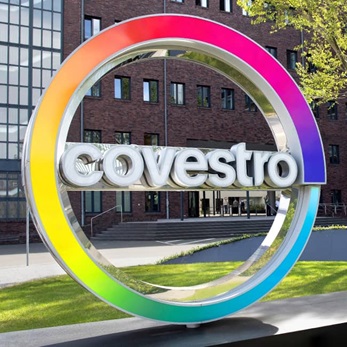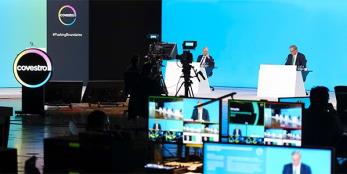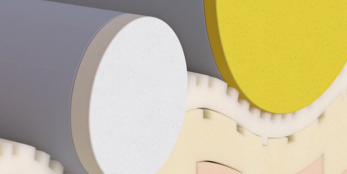Before working with this product, you must read and become familiar with the available information on its risks, proper use, and handling. Information is available in several forms, e.g., in particular in the currently valid safety data sheets and product labels. For further information contact your Covestro representative.
Product description
Bayfol® HX120 is a light-sensitive, self-processing photopolymer film which can be used to manufacture reflection and transmission volume-phase holograms. Bayfol® HX120 film can be recorded with appropriate laser light within the spectral range of 440 nm to 680 nm and is optimized for the spectral range of 500 nm to 680 nm.Bayfol® HX120 film consists of a three layer stack of a substrate, the light-sensitive photopolymer and a protective cover film. A triacetate (TAC) substrate and a polyethylene terphthalate (PET) protective cover film are used.
Typical Values
Optical Properties
| Property | Test Condition | Value | Unit | Standard |
|---|---|---|---|---|
| Typical substrate thickness | 60 | microns | acc. to ISO 4593, 23°C | |
| Typical photopolymer thickness | 30 | microns | IR Interferometer | |
| Typical cover layer thickness | 50 | microns | acc. to ISO 4593, 23°C | |
| Typical recording dosage needed to achieve above ∆n1 values | See Annex graph 2, for details of the recording dosage | mJ/cm² | ||
| Light transmittance | (Unrecorded film, w/o cover foil) | See Annex graph 1, for details of the transmittance spectrum | % | ASTM E 01348 |
| Maximum refractive index modulation ∆n1 per recording wavelengt λ | acc. to ISO 17901-2 | |||
| λ = 633 nm | > 0,04 | |||
| λ = 532 nm | > 0,04 |
Storage
The unrecorded photopolymer film should be stored in the original and sealed Covestro packaging that is used for delivery. The unrecorded photopolymer film should be protected from light, humidity, heat , foreign materials and compressive load.Recommended storage temperature: +15 °C to +25 °C.Recommended relative humidity 45 % to 55 %
Storage time
Storage time 6 month.
Processing
Reflection Holograms in 2-Beam GeometryIn this recording geometry the photopolymer film is laminated onto a glass plate (75 mm x 50 mm x 1 mm). The holographic recording is done with two coherent and collimated laser beams (plane waves), which penetrate the prepared sample from its two different surfaces. Both laser beams have S-polarization to maximize the interference contrast (fringe visibility) of the holographic recording.The holographic recording itself is done with dosages which correspond to the product of the total incident power density (PR + PS) multiplied by the individual exposure times, t. More detailed conditions are depicted in the two following figures.The ratio (PS / PR) = 1.29 compensates for the different size of the projected beam cross sections onto the sample surfaces and the different losses due to Fresnel reflections at the air sample interfaces in such a way that inside the photopolymer layer the beam ratio is equal to 1. This again facilitates maximum fringe visibility during the holographic recording.After the holographic recording, the material is bleached using a dosage of approx. 5 J/cm² in the UV spectral range and simultaneously approx. 5 J/cm² in the visible spectral range.
To determine the performance of the hologram, the diffraction efficiency η of the recorded hologram is measured with respect to the rotation angle α (the holographic film / glass sandwich is mounted on a rotation stage). The resulting Bragg curve η(α) is analyzed according to the Kogelnik theory* , to deduce the performance parameters ηmax, Δn1 and the effective thickness shrinkage. The effective thickness shrinkage is obtained from the angular shift ε, which measures the deviation from the recording angle α to the angle at which ηmax is achieved. This thickness shrinkage is incorporated in the fit of Δn1 according to Kogelnik theory.The mean refractive index used for the calculation is 1.51.By varying the recording times the dosage response curves for Δn1 at the different recording wavelengths, λ = 633 nm, 532 nm and 457 nm, can be obtained. Source: *Kogelnik, H., "Coupled wave theory for thick hologram gratings", The Bell System Technical Journal 48(9), 2909-2947 (1969) Graph 1: Transmittance Graph 2: Index Modulation
Health and Safety Information
Disclaimer
General
The manner in which you use our products, technical assistance and information (whether verbal, written or by way of production evaluations), including any suggested formulations and recommendations, are beyond our control. Therefore, it is imperative that you test our products to determine suitability for your processing and intended uses. Your analysis must at least include testing to determine suitability from a technical, health, safety, and environmental and regulatory standpoint. Such testing has not necessarily been done by Covestro, and Covestro has not obtained any approvals or licenses for a particular use or application of the product.
Unless we otherwise agree in writing, all products are sold strictly pursuant to the terms of our standard conditions of sale which are available upon request.
All information and including technical assistance is given without warranty or guarantee and is subject to change without notice. It is expressly understood and agreed by you that you assume and hereby expressly release indemnify us and hold us harmless from all liability, in tort, contract or otherwise, incurred in connection with the use of our products, technical assistance, and information. Any statement or recommendation not contained herein is unauthorized and shall not bind us. Nothing herein shall be construed as a recommendation to use any product in conflict with any claim of any patent relative to any material or its use. No license is implied or in fact granted under the claims of any patent.
Non Medical and non Food Contact
This product is not designated for the manufacture of a medical device or of intermediate products for medical devices (1). This product is also not designated for other specifically regulated applications (e.g. including cosmetics, plant protection, fertilisers, plant strengtheners, food processing, food contact and others). If the intended use of the product is for the manufacture of a medical device or of intermediate products for medical devices or for other specifically regulated applications Covestro must be contacted in advance to provide its agreement to sell such product for such purpose. Nonetheless, any determination as to whether a product is appropriate for use in a medical device or intermediate products for medical devices, for Food Contact products or cosmetic applications must be made solely by the purchaser of the product without relying upon any representations by Covestro.
1) Please see the Guidance on Use of Covestro Products in a Medical Application document.
Sample
Any samples provided by Covestro are for testing purposes only and not for commercial use.
Typical Value
These values are typical values only. Unless explicitly agreed in written form, they do not constitute a binding material specification or warranted values. Values may be affected by the design of the mold/die, the processing conditions and coloring/pigmentation of the product. Unless specified to the contrary, the property values given have been established on standardized test specimens at room temperature.
Contact
Please use our contact form or contact us directly by sending an e-mail to technical-datasheets@cx.covestro.com .







